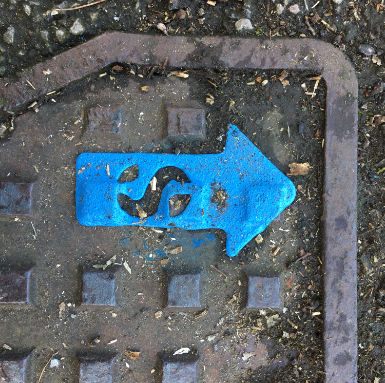Maintenance of drainage systems to prevent flooding and water pollution
Every building has a drainage system. In fact, most have two – a foul drainage system that takes waste from toilets, showers etc. and a storm/surface water drainage system that takes rainwater from roofs and paved areas. Older buildings may have a combined system, and in some locations the infrastructure buried under the street is a combined sewer – a legacy from the pioneering days of city sewerage systems.
As with maintenance of any building services systems, the first step is to know what you’ve got. Every site should have a drainage plan, showing which drains are located where, what direction they flow in and what they connect to. If there isn’t one, it’s not hard to create one – even though the pipes are buried, there’s plenty of evidence above ground in the form of manholes.
When there is a drainage plan, it’s worth checking how correct and up-to-date it is. Sometimes, the exercise of doing this brings up evidence of mis-connections, such as a new loo discharging into a storm manhole. It’s also worth marking drain covers with the service (F for foul or S for storm) and a direction arrow.
In foul drainage systems, the biggest headaches are caused by things going down the drain which shouldn’t – like wet wipes, sanitary products and hand towels. So the best form of preventative maintenance is to keep building occupants informed, with polite notices and clearly-marked bins in strategic places. Then there is the fats, oils and greases (FOG) that go down the plughole in catering establishments. If these find their way into the drains and sewers, they’re pretty much guaranteed to solidify and cause blockages – sometimes known as ‘fatbergs’. That’s why there should always be an interceptor in place, also known as a grease trap. This needs maintenance – the generic frequency for cleaning out a grease trap, stated in SFG20 (a common approach to planned preventative maintenance), is monthly. But this will be highly dependent on how the facility is used.
If blockages go unchecked, they may also go unnoticed. That is until sewage starts backing up into the building, or overflowing into storm sewers, which eventually discharge into lakes and rivers. These are delicate ecosystems, and the introduction of detergents and faecal matter can be very harmful to aquatic life and of course humans.
Rain, can pick up contaminants from both the air and the land, so once it has reached a storm/surface water drainage system, it has picked up dirt, oil and chemicals from air pollution, roofs and paved areas. Traditional systems have no means of dealing with this, and also must be sized for occasional extreme storm events, so the pipes are very large and mostly used at a fraction of their capacity. Sustainable drainage systems, or SuDS, attenuate the flow of rainwater to watercourses and emulate the way natural ecosystems treat this water. But they need maintenance. For example, any tree routes that could block a soakaway should be trimmed annually, and green roofs may require weeding on a weekly basis during the growing season.
For more information on the maintenance of drainage systems, please explore the BSRIA Information Service.
This article was originally published on the BSRIA Blog on August 12 2020. It was written by David Bleicher, BSRIA Publications Manager.
--BSRIA
[edit] Related articles on Designing Buildings
- Approved Document H.
- BSRIA articles.
- BSRIA.
- Cesspool.
- Difference between drains and sewers.
- Drainage.
- Drainage and sewerage management plans DSMPs.
- Grease management.
- Private sewer.
- Public sewer.
- Rain gutter.
- Rainwater downpipe.
- Rainwater harvesting.
- Safe working in drains and sewers.
- Septic tank.
- Sewerage.
- Soakaway.
- Sustainable urban drainage systems SUDS.
Featured articles and news
RTPI leader to become new CIOB Chief Executive Officer
Dr Victoria Hills MRTPI, FICE to take over after Caroline Gumble’s departure.
Social and affordable housing, a long term plan for delivery
The “Delivering a Decade of Renewal for Social and Affordable Housing” strategy sets out future path.
A change to adoptive architecture
Effects of global weather warming on architectural detailing, material choice and human interaction.
The proposed publicly owned and backed subsidiary of Homes England, to facilitate new homes.
How big is the problem and what can we do to mitigate the effects?
Overheating guidance and tools for building designers
A number of cool guides to help with the heat.
The UK's Modern Industrial Strategy: A 10 year plan
Previous consultation criticism, current key elements and general support with some persisting reservations.
Building Safety Regulator reforms
New roles, new staff and a new fast track service pave the way for a single construction regulator.
Architectural Technologist CPDs and Communications
CIAT CPD… and how you can do it!
Cooling centres and cool spaces
Managing extreme heat in cities by directing the public to places for heat stress relief and water sources.
Winter gardens: A brief history and warm variations
Extending the season with glass in different forms and terms.
Restoring Great Yarmouth's Winter Gardens
Transforming one of the least sustainable constructions imaginable.
Construction Skills Mission Board launch sector drive
Newly formed government and industry collaboration set strategy for recruiting an additional 100,000 construction workers a year.
New Architects Code comes into effect in September 2025
ARB Architects Code of Conduct and Practice available with ongoing consultation regarding guidance.
Welsh Skills Body (Medr) launches ambitious plan
The new skills body brings together funding and regulation of tertiary education and research for the devolved nation.
Paul Gandy FCIOB announced as next CIOB President
Former Tilbury Douglas CEO takes helm.
UK Infrastructure: A 10 Year Strategy. In brief with reactions
With the National Infrastructure and Service Transformation Authority (NISTA).
























